The following plants are recommended for erosion control. All are native, and most are good for moist, shaded conditions, which are often the conditions found in eroding yards.
Native Ground Covers and Perennials
Ferns
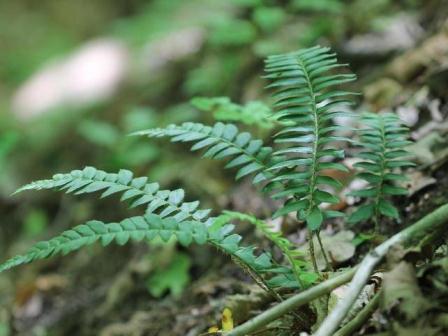
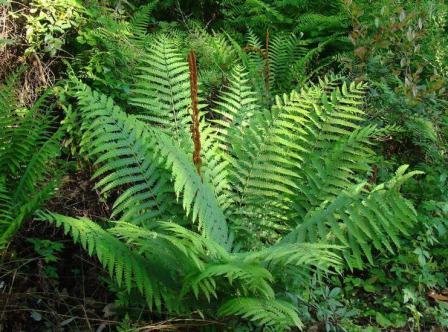
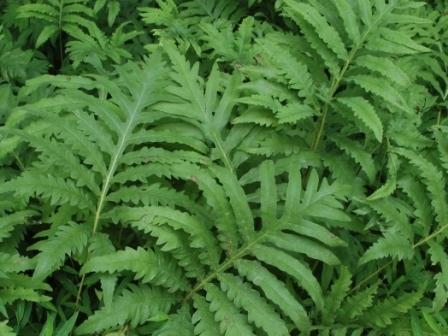
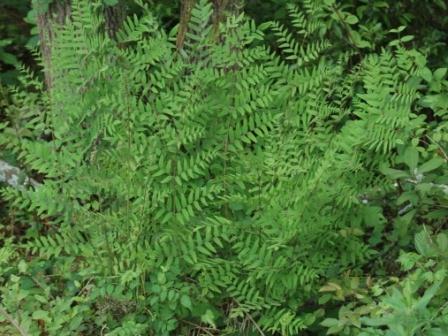
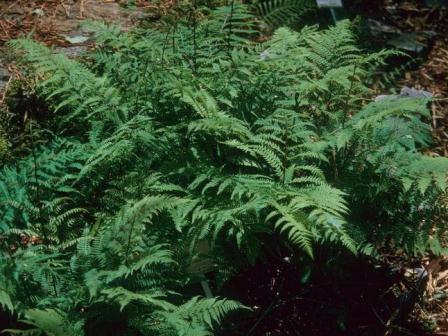
From left to right:
- Christmas fern, Polystichum acrostichoides. Grows 1-2’. Glossy, green fronds year-round. Silvery fiddleheads emerge in early spring.
- Cinnamon fern, Osmunda cinnamomea. Grows 2-5’, nice red-brown spore fronds in summer.
- Sensitive fern, Onoclea sensibilis. Varies in height from a few inches to more than 3 feet. Pale red fiddleheads appear in the spring. The stalks have a beaded appearance.
- Royal fern, Osmunda regalis. Fronds grow 2-5’ in moist soils, bright green foliage resembles that of the pea family
- Lady fern, Athyrium filix-femina. Approximately 1.5 feet. Light green, finely divided fronds. Grows well in well-drained soils in part shade to full shade. Tolerates drier soils than most ferns.
Others:
- New York fern, Thelypteris noveboracensis. Grows 1-2’. Fronds are yellow-green and may emerge singly or in small clusters. Has potential to form dense ground cover.
- Wood fern, Dryopteris marginalis or dryopteris intermedia. Approximately 1.5 feet. Broad, dark evergreen fronds that form a vase-like circle from the rootstock. Golden brown, furry fiddleheads arise in spring.
- And more. Most any native fern likes shady, moist conditions.
Other Groundcovers and Perennials
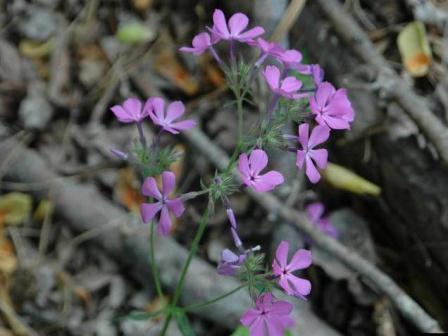 Woodland phlox, Phlox divaricata. Violet, white or pink in mid spring. Usually 1 1/2' in height.
Woodland phlox, Phlox divaricata. Violet, white or pink in mid spring. Usually 1 1/2' in height.
Similar: Creeping phlox, Phlox stolonifera. A groundcover with pink/violet flowers in spring; semi-evergreen.
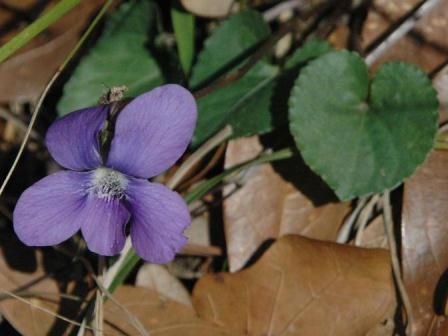 Violets, Viola spp. There are many different varieties. Make sure to ask at the nursery for a native, hardy violet that would be a good groundcover.
Violets, Viola spp. There are many different varieties. Make sure to ask at the nursery for a native, hardy violet that would be a good groundcover.
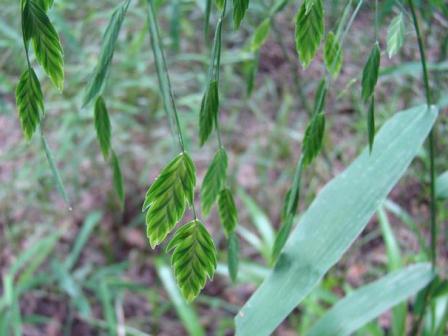 River oats (grass), Chasmanthium latifolium. 2-5 feet. Spreads very quickly so a couple of plants go a long way over time.
River oats (grass), Chasmanthium latifolium. 2-5 feet. Spreads very quickly so a couple of plants go a long way over time.
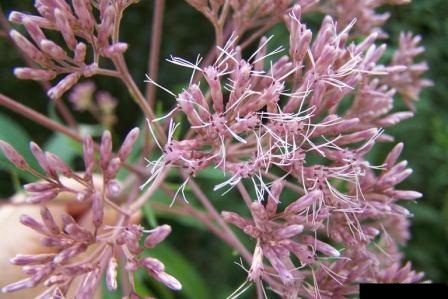 Joe pye weed, Eupatorium fistulosum, also eupatorium dubium (fistulosum gets to 10', dubium gets to 5'). Pink flowers in late summer, early fall. Can be pruned to keep it shorter.
Joe pye weed, Eupatorium fistulosum, also eupatorium dubium (fistulosum gets to 10', dubium gets to 5'). Pink flowers in late summer, early fall. Can be pruned to keep it shorter.
Common boneset, Eupatorium perfoliatum. Up to 5' with white flowers in late summer. Can be pruned to keep it shorter.
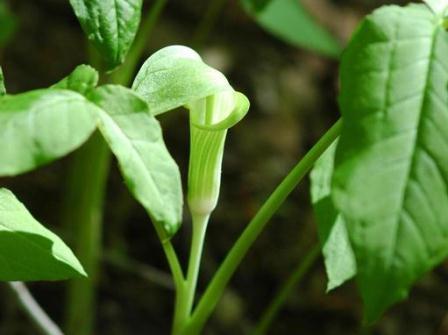 Jack-in-the-pulpit, Arisaema triphyllum. 1-3' large green bell shaped flower with bright red berries in late summer.
Jack-in-the-pulpit, Arisaema triphyllum. 1-3' large green bell shaped flower with bright red berries in late summer.
Foamflower, Tiarella cordifolia. White flower spires are 0.5-1’ tall in spring and nice foliage all year round.
Wild ginger, Asarum canadense. Grows less than 1’. Great foliage spring through fall, dies back in winter.
Golden ragwort, Packera aurea. Stems of 1-3’ in height, with deep golden-yellow flowers. Foliage is dark-green above and purple beneath.
White wood aster, Eurybia divaricata. 0.5 - 3', small white flowers July to October. Will spread.
Wild geranium, Geranium maculatum. Very beautiful, purple-rose flowers sit on 1-3’ stem in spring.
Blue wood sedge, Carex glaucodea. Grass-like sedge forms clumps, grows to 0.5 - 2 feet. A native alternative to liriope. Moist to dry conditions.
American alumroot, Heuchera americana. Comes in many cultivars with bronze and purple leaves and is semi-evergreen. Its delicate bell-shaped flowers sit on sticky flower stalk less than 1’ tall in May-June.
Virginia bluebells, Mertensia viginica. 2', pink, white or blue flowers in early spring but then dries up until next spring so not good for erosion control; very beautiful though.
Virginia creeper, Parthenocissus quinquefolia. Woody, deciduous vine spreads quickly and is limited in height by the structure it climbs. Leaves turn red and purple in early fall.
Great blue lobelia, Lobelia silphilitica. Blue-violet flowers in late summer-early fall. Usually 2-3' in height.
Native Shrubs
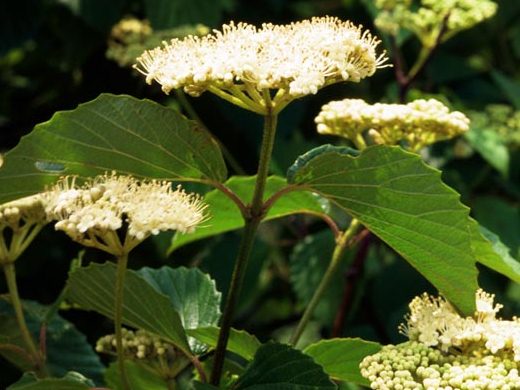 Arrowwood viburnum, Viburnum dentatum. White flower in late spring, purplish-red fall color, black berries in late fall approximately 6-10', well suited for full shade conditions.
Arrowwood viburnum, Viburnum dentatum. White flower in late spring, purplish-red fall color, black berries in late fall approximately 6-10', well suited for full shade conditions.
Similar: Maple-leaf viburnum, Viburnum acerifolium. White flowers in June, blue to black berries, 3-6 feet. Good for slopes and areas prone to erosion.
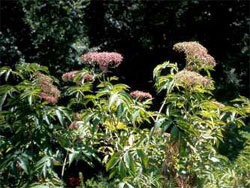 Elderberry, Sambucus nigra. White flower early summer, black berries in late summer. Approximately 6-10 feet.
Elderberry, Sambucus nigra. White flower early summer, black berries in late summer. Approximately 6-10 feet.
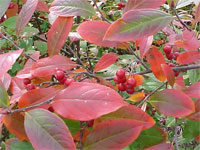 Red chokeberry, Photinia pyrifolia. White flower in mid-spring, red berries in fall, crimson foliage in fall. Approximately 6-10'.
Red chokeberry, Photinia pyrifolia. White flower in mid-spring, red berries in fall, crimson foliage in fall. Approximately 6-10'.
Similar: Black chokeberry, Photinia melanocarpa. Black berries and not quite as tall as red chokeberry, approximately 4-6' maximum.
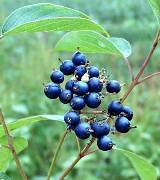 Silky dogwood, Cornus amomum. 6' white flowers in spring, good for erosion control.
Silky dogwood, Cornus amomum. 6' white flowers in spring, good for erosion control.
Ninebark, Physocarpus opulifolius. White flowers in May, red capsule like fruit very interesting in summer, yellow to purple fall color. Many cultivars with cool colors of foliage available at nurseries but make sure to check requirements for water/sun. Not all can take really wet areas. Approximately 6-10'.
Virginia sweetspire, Itea virginica. White flower spires in early spring, crimson foliage in fall, good in masses. Approximately 5-8'. Dwarf varieties at nurseries.
Sweet pepperbush, Clethra alnifolia. Also known as summersweet. Sweet smelling white flower in summer, 6-10'.
Winterberry holly, Ilex verticillata. Need a male and a female plant if you want berries. Nondescript white flowers in late spring, amazing red berries fall-winter. Approximately 6-10', well suited for full shade conditions.
Highbush blueberry, Vaccinium corymbosum. 6-8', white bell-shaped flowers in early spring, blue berries in summer, bright red to violet color in fall. Very suited for full shade.

